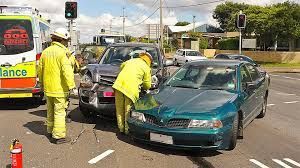Dangerous Driving Cause Death or GBH
Chris has considerable experience in acting for clients who are involved in motor vehicle accidents involving death or GBH. He has acted for a variety of clients who find themselves facing serious criminal charges and the real possibility of jail.
Chris also has considerable experience acting for heavy vehicle drivers and operators who as a result of a truck accident face criminal prosecutions from police and the National Heavy Vehicle Regulator.
Dangerous driving
Dangerous driving occasioning death is satisfied if the vehicle driven by the driver is involved in an impact occasioning the death of another and the driver was, at the time of the impact, driving the vehicle:
(a) under the influence of intoxicating liquor or of a drug, or
(b) at a speed dangerous to another person.
(c) in a manner dangerous to another person.
A conviction for this offence could result in imprisonment for 10 years.
Aggravated dangerous driving occasioning death is satisfied if a person commits the offence of dangerous driving, occasioning death in circumstances of aggravation.
Dangerous driving
A conviction for an offence under this subsection could result in imprisonment for 14 years.
Dangerous driving occasioning grievous bodily harm (GBH) is satisfied if the vehicle driven by the person is involved in an impact occasioning grievous bodily harm to another and the driver was, at the time of the impact, driving:
(a) under the influence of intoxicating liquor or of a drug or
(b) at a speed dangerous to another person or
(c) in a manner dangerous to another person.
A conviction for this offence could result in imprisonment for 7 years.
Aggravated dangerous driving occasioning grievous bodily harm is satisfied if the person commits the offence of dangerous driving occasioning GBH in circumstances of aggravation.
A conviction for this offence could result in imprisonment for 11 years.
“circumstances of aggravation” means any circumstances at the time of the impact occasioning death or GBH in which:
(a) the prescribed concentration of alcohol was present in the accused’s breath or blood, or
(b) the accused was driving the vehicle concerned on the road at a speed that exceeded the applicable speed limit by more than 45 kilometres per hour, or
(c) the accused was driving the vehicle to escape pursuit by a police officer, or
(d) the accused’s ability to drive was very substantially impaired by the fact that the accused was under the influence of a drug (other than intoxicating liquor) or a combination of drugs(whether or not intoxicating liquor was part of that combination).

Dangerous driving
Defences It is a defence to any charge under this section if the death or GBH occasioned by the impact was not in any way attributable (as relevant):
(a) to the fact that the person charged was under the influence of intoxicating liquor or of a drug or a combination of drugs, or
(b) to the speed at which the vehicle was driven, or
(c) to the manner in which the vehicle was driven.
These sections also apply to death, or GBH occasioned in single-vehicle accidents, such as death or GBH to a passenger from rolling a car over or hitting a tree. It could also result from an object that has fallen from your vehicle and is in motion.
The importance of evidence gathering as early as possible can not be overstated. Chris Kalpage was defending a case of dangerous driving cause death resulting from a motorcycle accident where the pillion rider was killed. The rider was severely injured and not expected to live; despite this, Chris attended the accident site within hours of the accident and examined it; there was still debris left at the scene and was still fresh. Accordingly, damage to foliage and the surroundings were present and could be utilised in the case. The rider survived with horrific injuries and left hospital months later with the need for significant rehabilitation for orthopaedic and brain injuries. He had no recollection of the accident. He was charged by police; the case that followed was based on various witness statements, none of whom saw the accident and a significant amount of scientific evidence. In the end, it was the careful investigation by Chris Kalpage, combined with his personal knowledge of motorcycles and the expert’s retained by him, that resulted in a successful outcome for the client.
Chris has extensive experience in investigating and defending serious accident cases.
SEE CHRIS'S ARTICLES FOR MORE INFORMATION
If you are charged with a traffic offence, contact Chris Kalpage, the head solicitor of Kalpage & Co Solicitors, 24/7, rather than facing worry and uncertainty on your own. For more details on driving while suspended, call us (02) 9230 0448 / 0418 211 074 or email: kalpage@aol.com.
Right to Silence
When you consider the potential penalties are 7 to 10 years in jail, there is good reason for caution when involved in a DangerousDriving Cause Death or Grievous Bodily Harm (GBH) MVA matter.
In criminal cases, there is an essential premise of a right to silence that is qualified to some extent by the police issuing a form of demand. But in relation to traffic accidents where someone is injured or killed, there is a more concerning element that affects your right to silence.
Let’s assume you’re riding a motorbike/car and an accident occurs where another road user, pillion or pedestrian is killed or injured. You could be arrested and taken to the Police station or required to attend the Police station. At the station, you cannot rely on your absolute right to silence as legislation requires you to give a version of the accident.
It is important to know that this version of events is limited to what happened. For example ‘I was traveling along the road and a pedestrian came from my right and I hit him’. That is a factual version of the accident. You do not have to go into any further detail such as your speed, etc. At the conclusion of the version, the police will wish to ask you questions for which they will have to administer a caution, in effect advising that you do not need to answer the subsequent questions.
When stressed, people don’t understand this distinction and sometimes don’t restrict themselves to a version in the first instance, or continue to talk once cautioned, potentially to their detriment.
When you consider the potential penalties are up to 10 years in jail, there is good reason for caution. It is one of the instances where it is beneficial to contact a lawyer and canvass your options.
This article was written for your information and interest only. It is not intended to be comprehensive and does not constitute and must not be relied on as legal advice. Please be aware that every case is different and the matters discussed may not be of specific relevance to your situation but may have a general application. You must seek specific advice tailored to your circumstances.
I will gladly talk to anyone on the phone for clarification:
Chris Kalpage
Kalpage & Co Solicitors
kalpageandcosolicitors.com.au
0418211074


